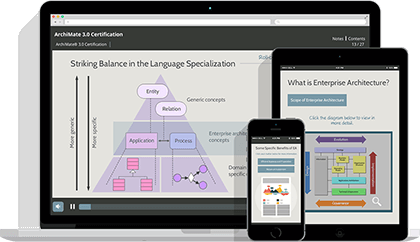


Student Review
Study ArchiMate® 3.1 with the award-winning online training team at Good e-Learning!
ArchiMate is an enterprise architecture modeling language designed to ease the process of explaining and displaying architectural concepts and functions. It provides a level of clarity that is essential for making informed decisions, and its shared terminology also greatly eases collaboration and communication between practitioners. Often used alongside TOGAF, ArchiMate is a highly valuable modeling tool for career enterprise architects.
Kickstart your ArchiMate certification training with Good e-Learning today!
In this opening module, we look at what the ArchiMate standard provides to the business, as well as why it is important to the Enterprise Architecture practitioner and the organization.
We introduce the key characteristics of the framework and offer a brief history of the standard since its conception in 2002.
Finally, we examine The Open Group and how ArchiMate harmonizes with the organization’s other standards, including TOGAF.
In this module, we take a look at the Open Group’s ArchiMate 3 Certification Program. We learn that it offers certification in three key areas: people, products, and ArchiMate training courses.
The certification for people program uses two levels: Foundation (Level 1) and Practitioner (Level 2). We take an in-depth look at the certification requirements needed for Level 1 and Level 2, as well as the examination conditions and pass marks.
This module introduces the basic concepts of Enterprise Architecture and the ArchiMate language.
We will be looking at the purpose and benefits of Enterprise Architecture, the ArchiMate standard’s relationship with Enterprise Architecture, the architectural domains covered by the standard, and how they map with TOGAF.
We also discuss the positioning of the ArchiMate framework with other modeling languages and modeling concepts.
In Module Four, “Language Structure”, we begin by looking at the framework’s design considerations and top-level language structure, moving on to its layers and framework.
We complete the topic with studies of abstraction, concepts and notations, nesting, use of color, and notational cues.
In this module, we will take a closer look at the ArchiMate generic metamodel and then turn our attention to relationships. When dealing with the metamodel, we will cover Behavior and Structure Elements as well as Specializations.
We will also study Motivation Elements, Strategy Elements, and Composite Elements.
In addition to the generic elements outlined in Module five, the ArchiMate language also defines a core set of generic relationships. Each of these relationships can connect a predefined set of source and target concepts.
This module covers the core ArchiMate relationships, including Structural, Dynamic, Grouping, Junction, and Specialization relationships.
In module seven, we look at both the Motivation and Strategy Elements in ArchiMate 3.
We will start by looking at the Motivation elements, which are used to model the motivations or reasons that guide the design or change of an Enterprise Architecture.
We will begin with the Stakeholder, Driver, and Assessment elements, followed by Goal, Outcome, Principle, Requirement, and Constraint, before concluding our study of the Motivation Elements with Meaning and Value.
We will then turn our attention to the Strategy Elements, namely Resource, Capability, and Course of Action.
In this module, we will explore the elements that make up the business layer in the ArchiMate Framework. The elements can be split into the active, behavior, and passive aspects. Other elements also fall into the composite category.
This module will explore the elements that make up the application layer in the ArchiMate Framework.
In module 10, we will explore the elements that make up the Technology layer in the ArchiMate Framework.
In module 11, we look at the physical elements, namely the Active Structure elements Equipment, Facility, and Distribution Network, the Behavior elements, and the Passive Structure Element (‘Material’).
A central issue in Enterprise Architecture is business-IT alignment and how these layers can be matched. This module describes the relationships that the ArchiMate language employs to denote this alignment, as well as the links between business, applications, and technology.
In this module, we look at the Implementation and Migration Elements and their Relationships.
We define a number of Implementation and Migration elements. We also study Relationships and Cross-aspect Dependencies.
The ArchiMate language provides a flexible approach in which architects and other stakeholders can use their own views on the Enterprise Architecture. In this approach, views are specified by viewpoints.
Viewpoints define abstractions on the set of models representing the Enterprise Architecture, each aimed at a particular type of stakeholder and addressing a particular set of concerns.
Viewpoints can be used to view certain aspects in isolation and to relate two or more aspects. In this module, we will address Stakeholders and Concerns, Views and Viewpoints, The Viewpoint Mechanism, Defining and Classifying Viewpoints, and Creating the View.
The ArchiMate language contains the basic elements and relationships that serve general EA modeling purposes only.
However, the language should also be able to support other, more specific, purposes, such as types of model analysis, the communication of architectures, and those of a certain domain (for example, the financial sector).
We therefore need a means of customizing the language, without burdening it with a lot of additional material. This module is therefore devoted to the customization mechanisms in ArchiMate 3.
This module will briefly explain how ArchiMate Certified Tools can be used to support EA modeling and analysis with ArchiMate 3.
Pearson Vue is the authorized certification exam provider for TOGAF, IT4IT, and ArchiMate and hosts exams worldwide through a network of test centers.
Worried about ArchiMate certification costs? This course comes with a FREE exam voucher (which must be used within a 12-month period) and is eligible for Exam Pledge (a free resit on us!)
For the ArchiMate 3 program there is no ‘Combined’ Part 1 and Part 2 exam. Therefore, students will need to take each exam part separately.
Candidates must take the ArchiMate Foundation exam and ArchiMate Practitioner exam separately, as there is no combined Part 1 and Part 2 exam.
When you are ready to use your free exam voucher, simply contact [email protected]. Exam voucher requests are typically processed within two working days, but please allow up to five. Students must request their exam voucher within the course access period, which starts from the date of purchase. For more information, please visit our Support & FAQs page.
This is a multiple-choice exam consisting of 40 questions
There is a time limit of 60 minutes to complete the exam
The pass mark for the exam is 60%: you must score at least 24 out of 40 questions correct
The exam is closed-book (you cannot make use of any resources or materials during the exam)
This is a multiple-choice exam consisting of 8 questions
There is a time limit of 90 minutes to complete the exam
Each correct answer is worth five points, each second-best answer is worth three points, and each third-best answer is worth one point. Each ‘distractor’ (incorrect) answer scores zero points
The pass mark for the exam is 70%: you must score at least 28 out of 40 questions correct
The exam is OPEN book
ArchiMate helps enterprise architects by giving them a graphical language for planning, creating, and presenting architectures.
ArchiMate models can also range in complexity, allowing users to create different versions of the same architecture for audiences with varying levels of knowledge.
ArchiMate essentially provides users with a set of instructions for visually communicating EA concepts. These models are far easier to interpret than most enterprise architecture frameworks, giving stakeholders the perspective to make the best decisions possible.
The framework can be used by anyone with knowledge of enterprise architecture, though it is most often utilized by TOGAF practitioners.
ArchiMate is among the best enterprise architecture tools because it makes EA diagrams much easier to understand for stakeholders and decision-makers. This makes it simpler for EA professionals to guide an organization’s strategic direction and gain the required support from senior management for transformation programs.
It also helps EA practitioners to communicate and collaborate with shared terms and best practices.
ArchiMate certifications can be extremely advantageous for career enterprise architects. Not only can it help them utilize frameworks like TOGAF, but it can also create networking opportunities and help them win roles with higher pay and more responsibilities.
The ArchiMate Foundation exam is closed-book, consists of 40 questions, lasts 60 minutes, and has a pass mark of 60%.
The ArchiMate Practitioner exam is open-book, features eight questions, lasts 90 minutes, and has a pass mark of 70%.
EA graphical ‘modeling languages’ are used to explain enterprise architecture concepts to audiences such as stakeholders or IT managers. This makes them easier to follow.
ArchiMate helps enterprise architects by giving them a graphical language for planning, creating, and presenting architectures. Even the best EA tools for modeling architectures do not always aim for simplicity, but the complexity of ArchiMate models can be varied depending on the audience’s experience and level of EA knowledge.
The Open Group is the business consortium behind several widely-used corporate methodologies and frameworks, including ArchiMate, TOGAF, and IT4IT.
ArchiMate and TOGAF were both created by The Open Group and complement each other extremely well.
Fully accredited:
Exam vouchers included:
Free resit (T&Cs apply):
Course duration: 20+ hours
Access period: 12 months
Tutor support:
Quizzes & practice exams:
Mobile compatible:
Good e-Learning support your learning needs at your own pace and in a proper environment that delivers the right amount of material at the right time. They haven’t lost sight of student’s individual needs either because they provide expert tutor support for individual queries!









Omniplex (Group) Ltd trading as Good e-Learning
45 Grosvenor Rd, St Albans, AL1 3AW
Company Number: 02584418
VAT Number: GB 434205135
"*" indicates required fields
"*" indicates required fields
At Good e-Learning, we’re dedicated to ensuring success. That’s why we offer Exam Pledge which entitles students to a free exam retake on any eligible course (see full list).
Resits are taken online via remote proctor. For more information about online exams, please visit our Support and FAQ pages.
As long as you have purchased a Good e-Learning course that is eligible for Exam Pledge and adhere to the conditions listed below, you will be able to request a free resit. If you fail your first exam, simply contact our support team to claim your retake voucher.
As long as you have completed the course in full and have scored at least 80% on the exam simulator, you will be eligible for Exam Pledge. Proof of date for the first exam failure must be provided and the resit must be booked within 3 months of the failed first exam. Exam Pledge is only available for courses purchased on or after 01/10/2019 and cannot be used for anyone sitting an exam for the third time. The course must be purchased directly through Good e-Learning and must have a valid order number. Please see full terms here.
"*" indicates required fields
"*" indicates required fields